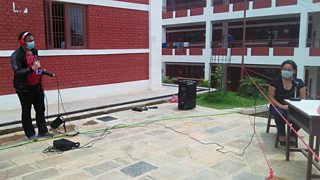A tale of two crises in Nepal
Bhuwan Timilsina
Project Manager, 主播大秀 Media Action, Nepal
Tagged with:

Wearing face mask and also maintaining physical distancing, Milijuli Nepali producer Prakash Sundas interviewing a woman in a quarantine centre near Kathmandu.
KATHMANDU – When a deadly earthquake hit Nepal in April 2015, survivors like me were too scared to live in our own houses, even if they were not damaged. We all moved to temporary shelters amidst a series of aftershocks.
Five years later, we find ourselves in the midst of another crisis: the COVID-19 pandemic. If the earthquake forced us to flee our houses, the pandemic has made it necessary to stay at home, and to maintain physical distancing if we step out.
After the earthquake, I had the opportunity to lead a 主播大秀 Media Action team to produce Milijuli Nepali (‘Together Nepal’) – a daily Lifeline radio programme that served local communities with lifesaving messages, initially about food, shelter and sanitation, and then about reconstruction and retrofitting.
Milijuli Nepali became an instant hit because of its unique style of delivering messages through an amalgamation of folk music and stories. After more than 1,200 episodes, broadcast through local radios in the 14 districts worst affected by the earthquake, Milijuli Nepali took a break in March 2019.
A little more than a year later, as Nepal battles against a deadly coronavirus outbreak, we've relaunched Milijuli Nepali – this time with a mission to communicate vital health messages related to COVID-19.
And I'm thrilled to have another opportunity to do what I love, and what I'm good at: using information as aid to save lives during a humanitarian crisis.
Restarting lifeline communication
When Nepal confirmed its first coronavirus case in February, fear, anxiety and uncertainty spread like wildfire, just as in the immediate aftermath of the earthquake. People had many unanswered questions about this invisible enemy that had already created a long trail of death and hardship around the world.
This situation got me thinking: I wish I could restart Milijuli Nepali so we could help people with trusted life-saving messages about COVID-19.
I then realised that I was not the only one to have thought that. I was called in for a meeting by our Country Director, Shobhana Pradhan, who had also felt the same urge to relaunch our Lifeline communication programme to save lives during the pandemic. That meeting was remarkably different from all our previous meetings at 主播大秀 Media Action. Everyone sat at least two metres away from each other, and everyone wore masks.
When a second coronavirus case was confirmed in March, Nepal announced an indefinite nationwide lockdown. The government also sealed off the long porous Nepal-India border, and all domestic and international flights were suspended indefinitely.
We rapidly realised supporting our local media partners to make Lifeline programming would need to be virtual – and started testing video conferencing for remote mentoring.
The lockdown slowed the spread of the virus in Nepal, allowing the government and hospitals to buy valuable time to better prepare for an outbreak. It also gave us time to plan how we could produce daily Lifeline content during a pandemic.
Producing this programme after the earthquake had its own challenges, but at least we could go to the field and interact with people directly. But how do we record people's voices for radio when it would be morally, ethically, and even legally wrong to meet them?
We developed our plans to produce radio content with minimum physical contact with communities, while still interacting with them as much as possible. Our plans are simple: avoid going to the field, and conduct interviews mostly over phone. Our regular production meeting also takes place virtually.
By setting up a dedicated phoneline, we've ensured people can leave us direct messages. Our voicemail has started receiving encouraging messages by people from remote and inaccessible areas, where people rely on Milijuli Nepali for health information. One recently recorded voicemail came from Ran Maya Kandel, who called us from Baglung district in Nepal's remote western hills. She told us that she eagerly waits for Milijuli Nepali as the programme delivers 'important messages in interesting ways'.
She added: "I love Milijuli Nepali because its producers talk exactly like me, or like how we village people speak."
Our work has come just in time. Since the lockdown was lifted on 21 July, coronavirus cases and COVID-19 deaths have surged. In the six months after the first case, 40 people died of COVID-19. But once the country re-opened, the death toll almost tripled in just the first month.
The second season of Milijuli Nepali is now being aired through 46 radio stations, strategically selected from across the country so everyone can listen to it, wherever they are. The timing of our relaunch could not have been any better.
Similar but different
In 2015, we named our Lifeline radio show Milijuli Nepali because we wanted the programme to motivate all the Nepali people to stand together to physically help each other in rebuilding their houses, lives and livelihoods ravaged by the earthquake.
But in 2020, the COVID-19 pandemic has completely changed the idea of helping each other to survive – it now means standing together by being physically apart.
In this new season, Milijuli Nepali still sticks to its approach of communicating trusted, actionable and vital messages in simple colloquial language, but it is now inspiring people to stand together in a way that has become the new normal for the post-pandemic world.
--
Bhuwan Timilsina is Project Manager for 主播大秀 Media Action, Nepal
